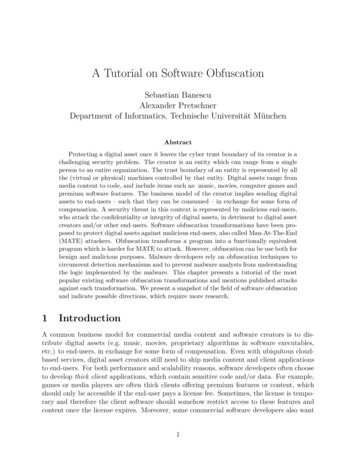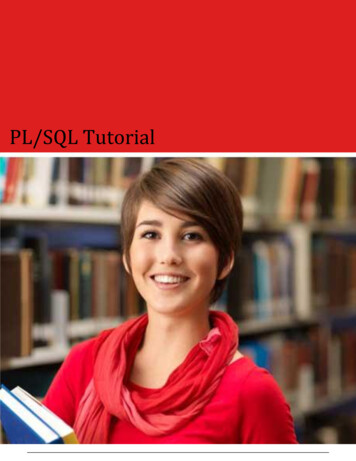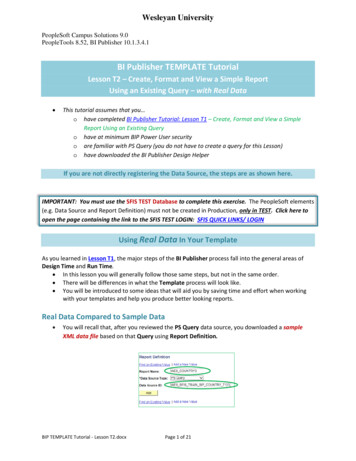
Transcription
A Tutorial on Software ObfuscationSebastian BanescuAlexander PretschnerDepartment of Informatics, Technische Universität MünchenAbstractProtecting a digital asset once it leaves the cyber trust boundary of its creator is achallenging security problem. The creator is an entity which can range from a singleperson to an entire organization. The trust boundary of an entity is represented by allthe (virtual or physical) machines controlled by that entity. Digital assets range frommedia content to code, and include items such as: music, movies, computer games andpremium software features. The business model of the creator implies sending digitalassets to end-users – such that they can be consumed – in exchange for some form ofcompensation. A security threat in this context is represented by malicious end-users,who attack the confidentiality or integrity of digital assets, in detriment to digital assetcreators and/or other end-users. Software obfuscation transformations have been proposed to protect digital assets against malicious end-users, also called Man-At-The-End(MATE) attackers. Obfuscation transforms a program into a functionally equivalentprogram which is harder for MATE to attack. However, obfuscation can be use both forbenign and malicious purposes. Malware developers rely on obfuscation techniques tocircumvent detection mechanisms and to prevent malware analysts from understandingthe logic implemented by the malware. This chapter presents a tutorial of the mostpopular existing software obfuscation transformations and mentions published attacksagainst each transformation. We present a snapshot of the field of software obfuscationand indicate possible directions, which require more research.1IntroductionA common business model for commercial media content and software creators is to distribute digital assets (e.g. music, movies, proprietary algorithms in software executables,etc.) to end-users, in exchange for some form of compensation. Even with ubiquitous cloudbased services, digital asset creators still need to ship media content and client applicationsto end-users. For both performance and scalability reasons, software developers often chooseto develop thick client applications, which contain sensitive code and/or data. For example,games or media players are often thick clients offering premium features or content, whichshould only be accessible if the end-user pays a license fee. Sometimes, the license is temporary and therefore the client software should somehow restrict access to these features andcontent once the license expires. Moreover, some commercial software developers also want1
Figure 1: Classification of protections against MATE attacks proposed in [40].to protect secret algorithms used in their client software, which give them an advantage overtheir competitors.One open challenge in IT security is protecting digital assets once they leave the cybertrust boundary of their creator. The creator of digital assets can range from a single personto an organization. The security threat in this context is represented by malicious end-users,who among other things, may want to: Use digital assets without paying the license fees required by the creators of that digitalasset. Redistribute illegal copies of digital assets to other end-users, sometimes in order tomake a profit. Make changes to the digital assets (e.g. by tampering with its code), in order to modifyits behavior.Such malicious end-users are also called Man-At-The-End (MATE) attackers [37], and theyhave control of the (physical or virtual) machine where the digital asset is consumed. Practically, any device under the control of an end-user (e.g. PC, TV, game console, mobile device,smart meter, etc.), is exposed to MATE attacks. A model of the MATE attacker capabilities,akin to the degree of formalization of the Man-In-The-Middle (MITM) attacker introducedby Dolev-Yao [51], is still missing from the literature. However, MATE attackers are assumed to be extremely powerful. They can examine software both statically using manualor automatic static analysis, or dynamically using state of the art software decompilers anddebuggers [89]. Shamir et al. [113] present a MATE attack, which can retrieve a secret keyused by a black-box cryptographic primitive to protect the system if it is stored somewherein non-/volatile memory. Moreover, the memory state can be inspected or modified during program execution and CPU or external library calls can be intercepted (forwarded ordropped) [133]. Software behavior modifications can also be performed by the MATE attacker by tampering with instructions (code) and data values directly on the program binaryor after they are loaded in memory. The MATE attacker can even simulate the hardwareplatform on which software is running and alter or observe all information during softwareoperation [35]. The only remaining line of defense in case of MATE attacks is to increase thecomplexity of an implementation to such an extent that it becomes economically unattractiveto perform an attack [35].2
Researchers, practitioners and law makers have sought several solutions for this challenge,all of which have their advantages and disadvantages. Figure 1 shows a classification ofthese solutions, proposed by Collberg et al. [40]. On the one hand, there are legal protectionframeworks that apply to some geographic regions, such as the Digital Millennium CopyrightAct [41] in the USA, the EU Directive 2009/24/EC [84], etc. On the other hand, there aretechnical protection techniques (complementing legal protection), which are divided into foursubcategories, namely: (1) software based obfuscation, (2) encryption (via trusted hardware),(3) server-side execution and (4) trusted (i.e. tamper-proof or tamper-evident) native code.The latter three subcategories will be briefly discussed in the related work section. Theobfuscation subcategory is the main focus, i.e. software-only protection that does not relyon trusted entities.An obfuscator is in essence a compiler that takes a program as input, and outputs afunctionally equivalent program, which is harder to understand and analyze than the inputprogram. The meaning of the phrases “functionally equivalent” and “harder to understandand analyze” will be discussed in this chapter. For instance, some classical compiler optimizations are also considered obfuscation transformations [40], because in order to make thecode more efficient, such optimizations may replace control-flow abstractions that are easy tounderstand by developers (e.g. loops), with other constructs which are less straightforward(e.g. goto statements).This chapter presents a tutorial of several popular obfuscation transformations togetherwith illustrative examples. It also mentions the MATE attacks published in the literature,which have been proposed for defeating each obfuscation transformation. The rest of thechapter is structured as follows. Section 2 presents classification dimensions for obfuscationtransformations. Section 3 presents classification dimensions for MATE attacks. Section 4presents a survey of obfuscation transformations and state of the art MATE attacks thatclaim to break each obfuscation. Section 5 discusses the current state of software obfuscationversus MATE attacks. Section 6 presents related work, and section 7 concludes the chapter.2Classification of Code Obfuscation TransformationsSeveral surveys and taxonomies for software obfuscation have been proposed in literature [8,40, 86, 94, 109]. This section describes the classification dimensions presented in those worksand discusses their advantages, disadvantages and overlaps. We present the classificationdimensions in increasing order of importance, starting with the least important category.2.1Abstraction Level of TransformationsOne common dimension of code transformations is the level of abstraction at which thesetransformations have a noticeable effect, i.e. source code, intermediate representation andbinary machine code. Such a distinction is relevant for usability purposes, e.g. a JavaScriptdeveloper will mostly be interested in source code level transformations and a C developer willmainly be interested in binary level. However, none of the previously mentioned taxonomiesand surveys classify transformations according to the abstraction level. This is due to thefact that some obfuscation transformations have an effect at multiple abstraction levels.3
Moreover, it is common for papers to focus only on a specific abstraction level, disregardingtransformations at other levels.2.2Unit of TransformationsLarsen et al. [86] proposed classifying transformations according to the of granularity atwhich they are applied. Therefore they propose the following levels of granularity: Instruction level transformations are applied to individual instructions or sequences ofinstructions. This is due to the fact that at the source code level, a code statementcan consist of one or more IR or Assembly instructions. Basic block level transformations affect the position of one or more basic blocks. Basicblocks are a list of sequential instructions that have a single entry point and end in abranch instruction. Loop level transformations alter the familiar loop constructs added by developers. Function level transformations affect several instructions and basic blocks of a particular subroutine. Moreover, they may also affect the stack and heap memory corresponding to the function. Program level transformations affect several functions inside an application. However,they also affect the data segments of the program and the memory allocated by thatprogram. System level transformations target the operating system or the runtime environmentand they affect how other programs interact with them.The unit of transformation is important in practice because developers can choose the appropriate level of granularity according to the asset they must protect. For example, looplevel transformations are not appropriate for hiding data, but they are appropriate for hiding algorithms. However, the same problem, as for the previous classification dimension,arises for the unit of transformation, namely the same obfuscation transformation may beapplicable to different units of transformation.2.3Dynamics of TransformationsThe dynamics of transformation – used by Schrittwieser et al. [109] – indicate whether atransformation is applied to the program or its data statically or dynamically. Static transformations are applied once during: implementation, compilation, linking, installation orupdate, i.e. the program and its data does not change during execution. Dynamic transformations are applied at the same times as static transformations, however, the programor its data also change during loading or execution, e.g. the program could be decoded atload time, because it was encoded on disk. Even though dynamic code transformationsare generally considered stronger against MATE attacks than static ones, they require thecode pages to be both writable and executable, because the code may modify itself during4
execution. This opens the door for remote attacks (e.g. code injection attacks [122]), whichare more dangerous for end-users than MATE attacks. Moreover, dynamic transformationsgenerally have a higher performance overhead than static transformations, because code hasto first be written (generated or modified) and then executed. Therefore, on the one hand,many benign software developers avoid dynamic transformations entirely. On the otherhand, dynamic transformations are heavily used by malware developers, because they arenot generally concerned about high performance overhead.2.4Target of TransformationsThe most common dimension for classifying obfuscation transformations is according to thetarget of transformations. This dimension was first proposed by Collberg et al. [40], whoindicated four main categories: layout, data, control and preventive transformations. In alater publication Collberg and Nagra [39] refined these categories into four broad classes:abstraction, data, control and dynamic transformations. Since the last class of Collberg andNagra [39] (i.e. dynamic transformations), overlaps with the dynamics of transformationdimension, described in subsection 2.3, we will use a simplification of these two proposalswhere we remove the dynamic transformations class and merge the abstraction, layout andcontrol classes. Therefore, the remaining transformation targets are: Data transformations, which change the representation and location of constant values(e.g. numbers, strings, keys, etc.) hard-coded in an application, as well as variablememory values used by the application. Code transformations, which transform the high-level abstractions (e.g. data structures,variable names, indentation, etc.) as well as the algorithm and control-flow of theapplication.This dimension is important for practitioners, because it indicates the goal of the defender,i.e. whether the defender wants to protect data or code. Note that obfuscation transformations which target data may also affect the layout of the code and its control-flow, however,their target is hiding data, not code. In practice data transformations are often used in combination with code transformations, to improve the resilience of the program against MATEattacks.Data transformations Data transformations can be divided into two subcategories:1. Constant data transformations, which affect static (hard-coded) values. Abstractly,such transformations are encoding functions which take one or more constant dataitems i (e.g. byte arrays, integer variables, etc.), and convert them into one or moredata items i0 f (i). This means that any value assigned to, compared to and basedon i is also changed according to the new encoding. There will be a trade-off betweenresilience on one hand, and cost on the other, because all operations performed on irequire c
A Tutorial on Software Obfuscation Sebastian Banescu Alexander Pretschner Department of Informatics, Technische Universit at Munc hen Abstract Protecting a digital asset once it leaves the cyber trust boundary of its creator is a challenging security problem. The creator is an entity which can range from a single person to an entire organization. The trust boundary of an entity is represented by all








![Database Management System [DBMS] Tutorial](/img/2/dbms-tutorial.jpg)
